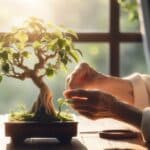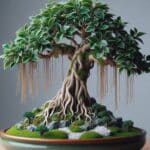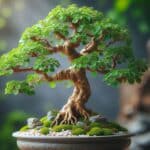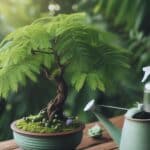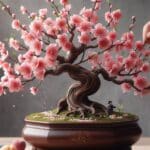Oak trees (Quercus suber) have a mighty symbolic meaning. This tree species is associated with strength, endurance, power, and ancient wisdom because it has a robust root system anchoring it firmly into place. These remarkable trees can live for over 1,000 years.
With such powerful spiritual significance, owning one of these trees is pretty tempting. They make excellent bonsai trees because they have small leaves and strong trunks, and the bark of this tree species is fascinating.
One of the most attractive features of this exciting tree is its vivid leaf colors. The leaves of deciduous bonsai varieties transform into brilliant orange, yellow-green, and reddish-brown hues during autumn, giving your little tree a rather spectacular appearance.
This type of tree species is trendy among bonsai creators because the bonsai species is relatively easy to grow and maintain. Let’s take a look at how to bonsai an oak.

Plant Facts
| Scientific name | Quercus |
| Common names | Quercus, Common Oak, European Oak, English Oak, Oak Tree |
| Family | Beech |
| Plant Type | Ornamental Tree or Shrub, Bonsai Tree |
| Height and Width | 60 – 80 ft. tall (natural), 1.6 ft. tall (bonsai) |
| Origin | Originates from America but also grows in cool to tropical latitudes of Asia, Europe, and North Africa |
| Flower colors | Small red flowers |
| Foliage color | Green/ blue-green, reddish brown, wine red, orange-red, or yellow depending on the season |
| Sun Exposure | 4 – 6 Hours of direct sunlight |
| Soil Type & pH | Well-drained acidic soil with a pH of 5.0 – 7.0 |
| Special features | Low Maintenance. Good for Containers? Vivid foliage color. Suitable for Bonsai |
What Does a Bonsai Oak Tree Look Like?
An oak bonsai is a smaller version of a traditional oak tree. These trees are usually specially trained or modified to maintain a shorter height and smaller foliage pattern. Bonsai oak trees are generally about 50 cm or 1.63 feet tall, producing small, lobed leaves and a stump with lots of rugged bark.
Some oak tree species are evergreen, while others are deciduous trees. Evergreen oak trees will have light to dark green foliage throughout the year. Deciduous trees will have light green foliage during the growing season, but the broad leaves will transform into golden, orange, or red tones when the tree starts dying back for winter.
It is very common to see these trees with twisted trunks or lots of dead trunk matter because bonsai artists often take extreme measures to make the oak tree appear older.
Where Do Oak Trees Grow?
Quercus is native to the Northern Hemisphere and is the American national tree because some of its oldest fossils are located in this region. These plants are also located in cool and tropical Asian, European, and North African latitudes.
How to Grow an Oak Bonsai Tree
Oaks are well suited for bonsai because they grow well in containers and are relatively easy to care for. It is a good plant species for bonsai beginners but they are prone to scarring and are sensitive to pruning. If you want to grow your own oak tree bonsai, follow the following steps.
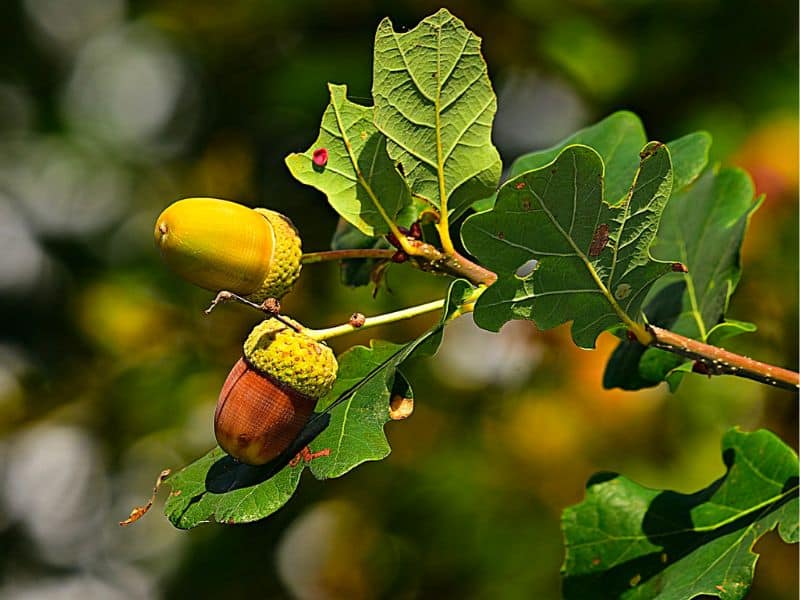
Propagation
Oak trees are usually grown from seed because cuttings don’t form roots. You can also buy an oak sapling between 6 inches and 2 feet tall from a local nursery.
If you are growing an oak tree from a seed, it is best to start with a healthy acorn. Here are the right steps for germinating acorns from seeds.
Step 1
Start by placing the acorns in cold water. Damaged acorns will drift and should be discarded. The acorns that sink to the bottom are healthy and suitable for planting.
Step 2
Plant the acorn in a pot with some potting mix soil. The acorns can be planted about one inch deep in well-drained soil and should be watered well.
Step 3
Keep the soil moist until winter. Refrain or reduce watering during winter time and start watering the seedlings again in early spring. The germinating acorn should sprout during spring season.
Step 4
When the seedling is strong, you can transplant it into a bigger pot or a bonsai pot if it is large enough to start your bonsai tree.
Please wait until the sapling is strong and about 6 inches tall before you start working on it. It is best to start working with your sapling in early spring before the first leaves appear if you want to train it into a bonsai tree.
Soil
You should plant your oak seed in well-drained soil inside a garden pot with plenty of drainage holes. Once the sapling is big enough to work with, it should be transplanted into another pot. This time, it is best to use a bonsai soil mixture that contains akadama, pumice, and lava rock or a mixture that includes peat moss and perlite.
Pruning and Training
Your oak bonsai tree will require regular pruning to maintain its shape. Pruning is usually done in early spring and throughout the growing season.
While hard pruning your tree, you should be very careful not to damage it because these trees can easily be scarred and become weak if you are not careful enough.
To prune your tree, you can start by removing damaged, diseased, or dead branches. After this, you can choose a desirable bonsai tree shape that suits the natural growth of your bonsai tree. Carefully prune away any ingrown or unwanted branches.
Your bonsai sapling can also be wired during early spring before the growing season begins. Wiring a bonsai is a great way to shape the branches into a more desirable bonsai shape.
Grab some copper or aluminum wire and wrap the wire around the branches so you can bend these delicate branches into a desired shape. The wires should be removed after about three months when they start to cut into the bark.
Repotting and Transplanting
Oak bonsai trees need to be repotted once every 2 – 3 years. Selecting a slightly larger pot to accommodate the growing bonsai for your repotting process is best. It is also best to repot your plant when it is actively growing in the spring.
To repot your tree, remove it from the old container and clear away all the dirt around the root system. Remove about one-third of the old root system and plant the tree in a suitable container with fresh bonsai soil.
Keep your miniature oak tree moist until the new roots take well.
How to Care for an Oak Bonsai Tree
When your young outdoor bonsai takes well to its new growing container, you should be careful to take good care of it. These trees are extremely hardy, but frost, pests, or natural elements can damage them. Here is a quick guide to help you take better care of your little bonsai.
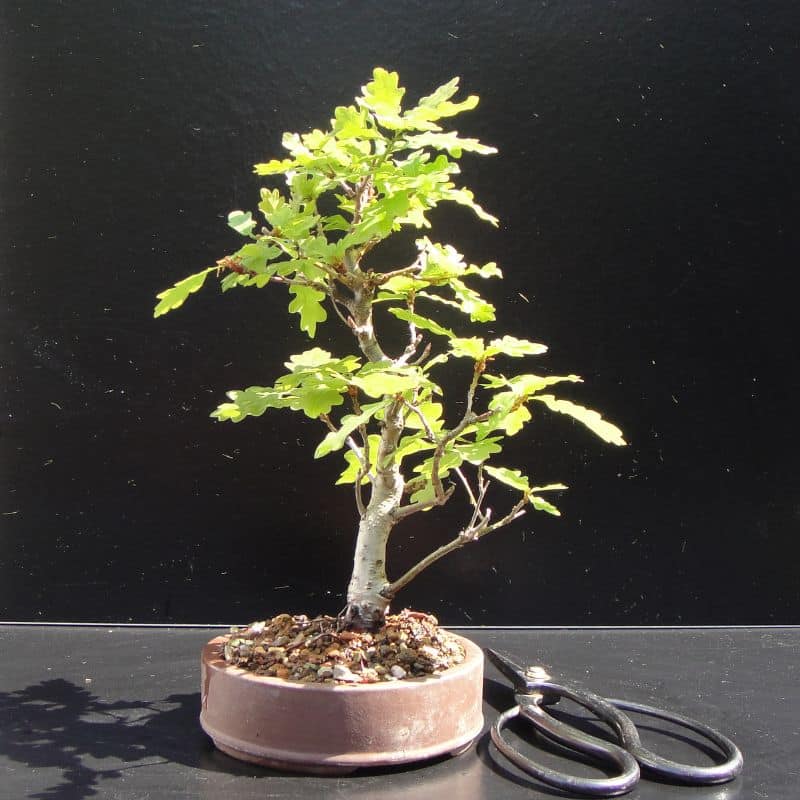
Water
Oak bonsai trees can develop root problems if they are kept in wet conditions but you should never let the rootball dry out completely. The plant should be watered thoroughly when the soil is almost completely dry. It is also important to reduce watering during winter or your little plant can die of frost.
Sunlight
Oak trees flourish if they receive about 6 hours of full sunlight per day. These outdoor plant species should be kept in a sunny spot in your garden during the warmer seasons of the month but can be brought indoors and placed in a sunny window when it is very cold outside.
Temperature and Humidity
These beautiful, slow-growing trees prefer a 40 – 50% humidity level. When they do like lots of humidity, you should be careful not to keep them in an area that is too humid because this might speed up fungal or mildew growth for the little tree.
If you are moving the tree indoors for winter, add a humidity tray next to it to keep it nice and moist.
Fertilizer
You can fertilize this tree by adding an organic fertilizer once a month or by adding a liquid fertilizer every week of its growing season. Avoid fertilizers that contain lots of nitrogen since this ingredient might cause the leaves to grow too big and can make your tree more vulnerable to diseases.
Pest and Diseases
Oak species can be vulnerable to pests, and bonsai tree varieties tend to suffer from the same issues as their adult counterparts. Let’s look at some of the most common issues to watch out for with these trees.
Bacterial Leaf Scorch
Bacterial leaf scorch or oak leaf blister is a very serious condition that can kill your tree. Treat this condition by removing the affected leaves with a good fungicide or chemical pesticide.
Powdery Mildew
To remove powdery mildew, you can start by removing affected branches and dead leaves. After doing this, you can treat the tree with a mixture of baking soda, dish detergent, and water.
Root Rot
Armillaria root rot is common for plants that stand in the water for too long. You can prevent this by reducing the trees’ watering schedule and by planting them in a suitable container with lots of drainage holes.
Common Varieties and Cultivars
There are many different oak varieties but not all species will be easy to turn into a bonsai because some varieties do have leaves that are too large or broad for a mini-scaled appearance. Here is a quick look at some other oak trees or varieties that are often used for bonsai creations.
- Black Oak
- White Oak
- Pine Oak
- Chestnut Oak
- Bur Oak
- English Oak
- Northern Red Oak
- Southern Red Oak
Conclusion
Oak bonsai is challenging to shape and train, but the trees are straightforward to maintain and care for once they achieve a desirable shape. These trees can offer you and future families lots of joy because they have an extremely long lifespan and are so easy to care for.
We hope that you will be successful with growing an oak sapling, and we are sure that you will learn a lot while turning your little oak tree into a lovely bonsai. Have fun on your bonsai journey.
See more:


